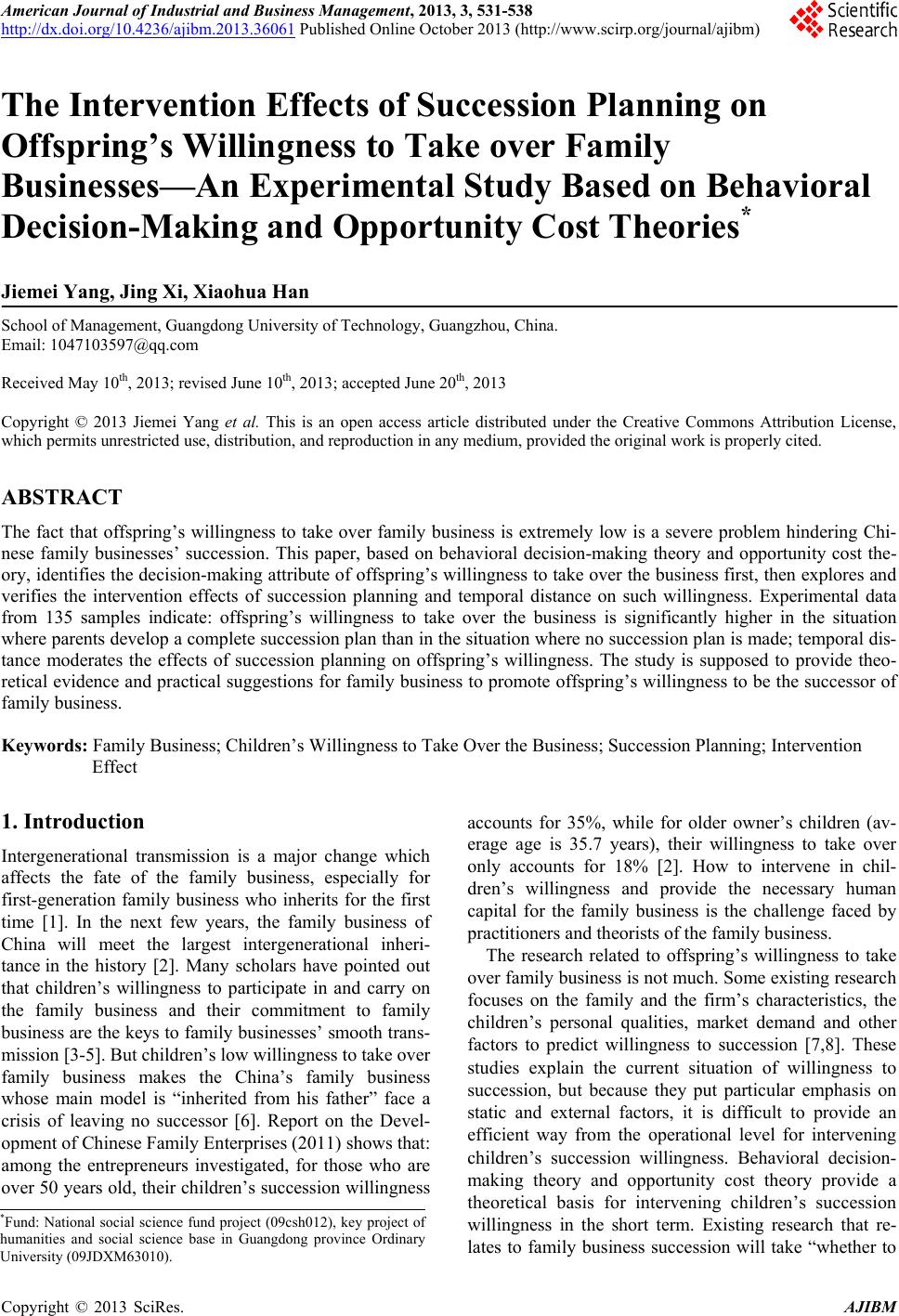 American Journal of Industrial and Business Management, 2013, 3, 531-538 http://dx.doi.org/10.4236/ajibm.2013.36061 Published Online October 2013 (http://www.scirp.org/journal/ajibm) 531 The Intervention Effects of Succession Planning on Offspring’s Willingness to Take over Family Businesses—An Experimental Study Based on Behavioral Decision-Making and Opportunity Cost Theories* Jiemei Yang, Jing Xi, Xiaohua Han School of Management, Guangdong University of Technology, Guangzhou, China. Email: 1047103597@qq.com Received May 10th, 2013; revised June 10th, 2013; accepted June 20th, 2013 Copyright © 2013 Jiemei Yang et al. This is an open access article distributed under the Creative Commons Attribution License, which permits unrestricted use, distribution, and reproduction in any medium, provided the original work is properly cited. ABSTRACT The fact that offspring’s willingness to take over family business is extremely low is a severe problem hindering Chi- nese family businesses’ succession. This paper, based on behavioral decision-making theory and opportunity cost the- ory, identifies the decision-making attribute of offspring’s willingness to take over the business first, then explores and verifies the intervention effects of succession planning and temporal distance on such willingness. Experimental data from 135 samples indicate: offspring’s willingness to take over the business is significantly higher in the situation where parents develop a complete succession plan than in the situation where no succession plan is made; temporal dis- tance moderates the effects of succession planning on offspring’s willingness. The study is supposed to provide theo- retical evidence and practical suggestions for family business to promote offspring’s willingness to be the successor of family business. Keywords: Family Business; Children’s Willingness to Take Over the Business; Succession Planning; Intervention Effect 1. Introduction Intergenerational transmission is a major change which affects the fate of the family business, especially for first-generation family business who inherits for the first time [1]. In the next few years, the family business of China will meet the largest intergenerational inheri- tance in the history [2]. Many scholars have pointed out that children’s willingness to participate in and carry on the family business and their commitment to family business are the keys to family businesses’ smooth trans- mission [3-5]. But children’s low willingness to take over family business makes the China’s family business whose main model is “inherited from his father” face a crisis of leaving no successor [6]. Report on the Devel- opment of Chinese Family Enterprises (2011) shows that: among the entrepreneurs investigated, for those who are over 50 years old, their children’s succession willingness accounts for 35%, while for older owner’s children (av- erage age is 35.7 years), their willingness to take over only accounts for 18% [2]. How to intervene in chil- dren’s willingness and provide the necessary human capital for the family business is the challenge faced by practitioners and theorists of the family business. The research related to offspring’s willingness to take over family business is not much. Some existing research focuses on the family and the firm’s characteristics, the children’s personal qualities, market demand and other factors to predict willingness to succession [7,8]. These studies explain the current situation of willingness to succession, but because they put particular emphasis on static and external factors, it is difficult to provide an efficient way from the operational level for intervening children’s succession willingness. Behavioral decision- making theory and opportunity cost theory provide a theoretical basis for intervening children’s succession willingness in the short term. Existing research that re- lates to family business succession will take “whether to *Fund: National social science fund project (09csh012), key project o humanities and social science base in Guangdong province Ordinary University (09JDXM63010). Copyright © 2013 SciRes. AJIBM 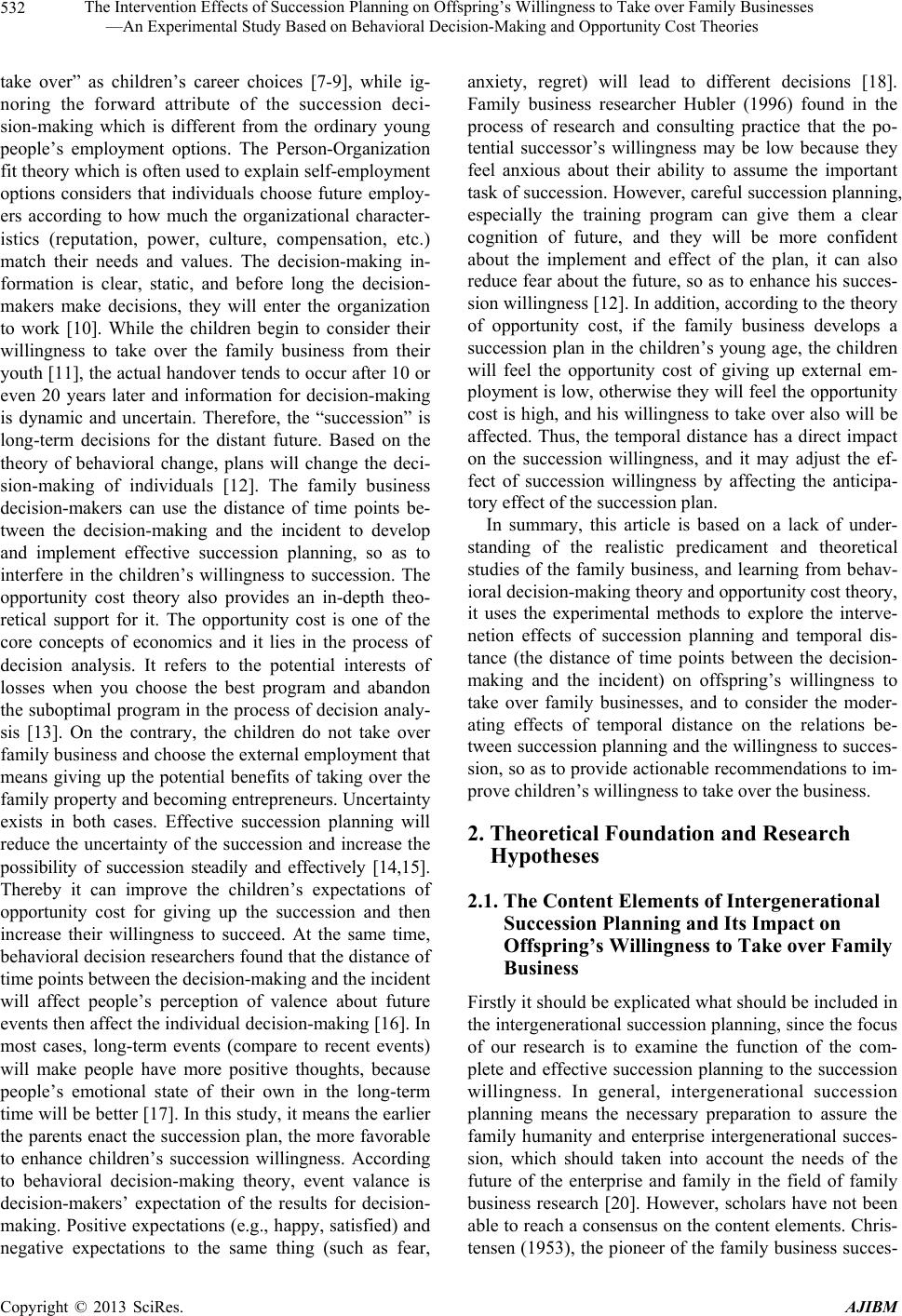 The Intervention Effects of Succession Planning on Offspring’s Willingness to Take over Family Businesses —An Experimental Study Based on Behavioral Decision-Making and Opportunity Cost Theories 532 take over” as children’s career choices [7-9], while ig- noring the forward attribute of the succession deci- sion-making which is different from the ordinary young people’s employment options. The Person-Organization fit theory which is often used to explain self-employ ment options considers that individuals choose future employ- ers according to how much the organizational character- istics (reputation, power, culture, compensation, etc.) match their needs and values. The decision-making in- formation is clear, static, and before long the decision- makers make decisions, they will enter the organization to work [10]. While the children begin to consider their willingness to take over the family business from their youth [11], the actu al handover tends to occu r after 10 or even 20 years later and information for decision-making is dynamic and uncertain. Therefore, the “succession” is long-term decisions for the distant future. Based on the theory of behavioral change, plans will change the deci- sion-making of individuals [12]. The family business decision-makers can use the distance of time points be- tween the decision-making and the incident to develop and implement effective succession planning, so as to interfere in the children’s willingness to succession. The opportunity cost theory also provides an in-depth theo- retical support for it. The opportunity cost is one of the core concepts of economics and it lies in the process of decision analysis. It refers to the potential interests of losses when you choose the best program and abandon the suboptimal pr ogram in the process of decision analy- sis [13]. On the contrary, the children do not take over family business and choose the external employment that means giving up the potential benefits of taking over the family property and becoming entrepreneurs. Uncertainty exists in both cases. Effective succession planning will reduce the uncertainty of the succession and increase the possibility of succession steadily and effectively [14,15]. Thereby it can improve the children’s expectations of opportunity cost for giving up the succession and then increase their willingness to succeed. At the same time, behavioral decision researchers found that the distance of time points between the decision-making and the incident will affect people’s perception of valence about future events then affect the individual decision-making [16]. In most cases, long-term events (compare to recent events) will make people have more positive thoughts, because people’s emotional state of their own in the long-term time will be better [17]. In this study, it means the earlier the parents enact the succession plan, the more favorable to enhance children’s succession willingness. According to behavioral decision-making theory, event valance is decision-makers’ expectation of the results for decision- making. Positive ex pectations (e.g., happy, satisfied) and negative expectations to the same thing (such as fear, anxiety, regret) will lead to different decisions [18]. Family business researcher Hubler (1996) found in the process of research and consulting practice that the po- tential successor’s willingness may be low because they feel anxious about their ability to assume the important task of succession. However, careful succession planning, especially the training program can give them a clear cognition of future, and they will be more confident about the implement and effect of the plan, it can also reduce fear about the future, so as to enhance his succes- sion willingness [12]. In addition, according to the theory of opportunity cost, if the family business develops a succession plan in the children’s young age, the children will feel the opportunity cost of giving up external em- ployment is low, otherwise they will feel the opportunity cost is high, and his willingness to take over also will be affected. Thus, the temporal distance has a direct impact on the succession willingness, and it may adjust the ef- fect of succession willingness by affecting the anticipa- tory effect of the succession plan. In summary, this article is based on a lack of under- standing of the realistic predicament and theoretical studies of the family business, and learning from behav- ioral decision-making theory and opportunity cost theory, it uses the experimental methods to explore the interve- netion effects of succession planning and temporal dis- tance (the distance of time points between the decision- making and the incident) on offspring’s willingness to take over family businesses, and to consider the moder- ating effects of temporal distance on the relations be- tween succession planning and the willingness to succes- sion, so as to provide action able recommendations to im- prove children’s willingness to take over the bu siness. 2. Theoretical Foundation and Research Hypotheses 2.1. The Content Elements of Intergenerational Succession Planning and Its Impact on Offspring’s Willingness to Take over Family Business Firstly it should be explicated what should be included in the intergeneratio nal succession planning, since the focus of our research is to examine the function of the com- plete and effective succession planning to the succession willingness. In general, intergenerational succession planning means the necessary preparation to assure the family humanity and enterprise intergenerational succes- sion, which should taken into account the needs of the future of the enterprise and family in the field of family business research [20]. However, scholars have not been able to reach a consensus on the content elements. Chris- tensen (1953), the pioneer of the family business succes- Copyright © 2013 SciRes. AJIBM 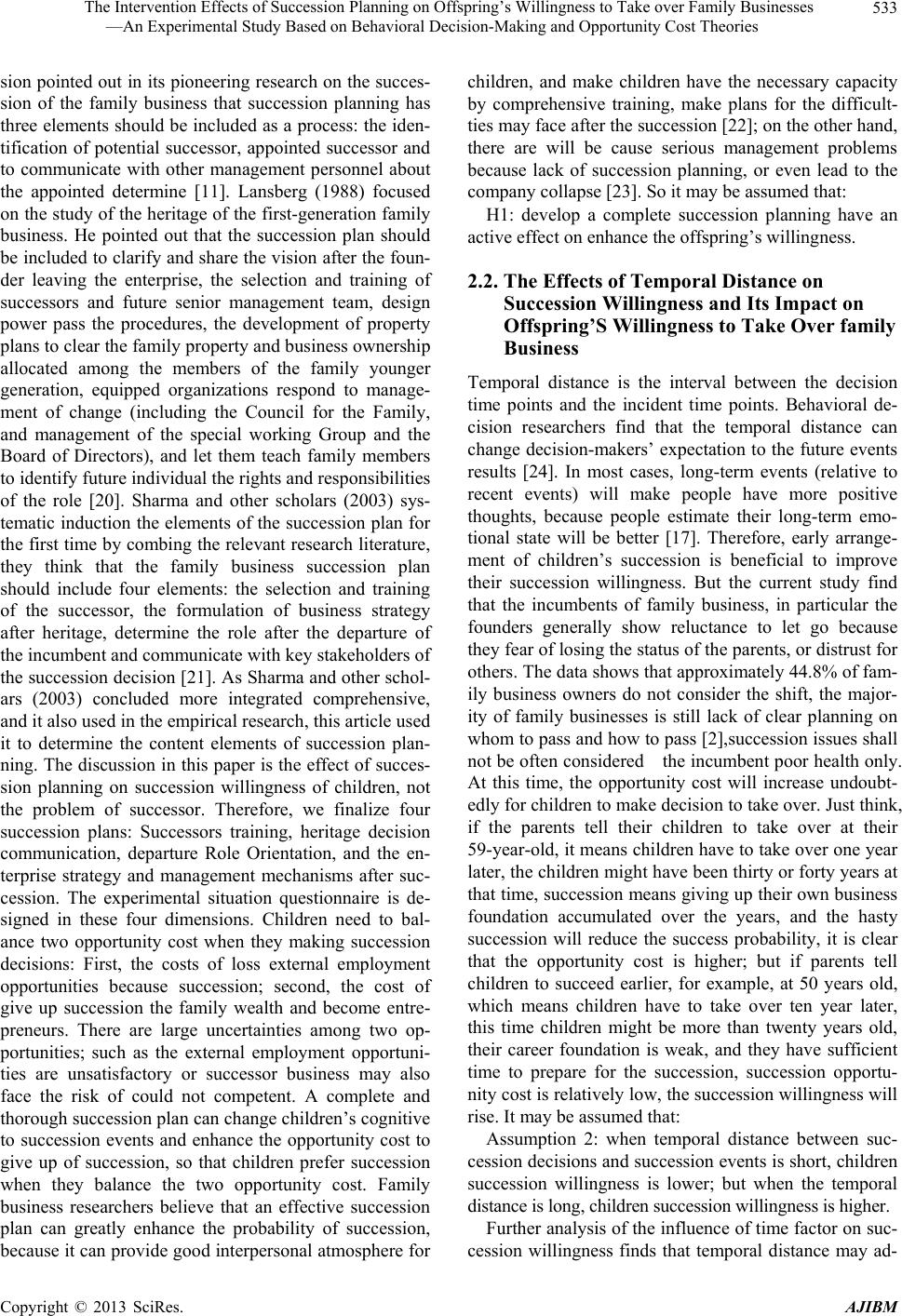 The Intervention Effects of Succession Planning on Offspring’s Willingness to Take over Family Businesses —An Experimental Study Based on Behavioral Decision-Making and Opportunity Cost Theories 533 sion pointed out in its pioneering research on the succes- sion of the family business that succession planning has three elements should be in cluded as a process: the iden- tification of potential successor, appointed successor and to communicate with other management personnel about the appointed determine [11]. Lansberg (1988) focused on the study of the heritage of the first-generation family business. He pointed out that the succession plan should be included to clarify and share the vision after the foun- der leaving the enterprise, the selection and training of successors and future senior management team, design power pass the procedures, the development of property plans to clear the family property and business ownership allocated among the members of the family younger generation, equipped organizations respond to manage- ment of change (including the Council for the Family, and management of the special working Group and the Board of Directors), and let them teach family members to identify future ind ividual the rights and responsibilities of the role [20]. Sharma and other scholars (2003) sys- tematic induction the elements of the succession plan for the first time by combing the relevant research literature, they think that the family business succession plan should include four elements: the selection and training of the successor, the formulation of business strategy after heritage, determine the role after the departure of the incumbent and communicate with key stakeholders of the succession decision [21]. As Sharma and other schol- ars (2003) concluded more integrated comprehensive, and it also used in the empirical research, this article us ed it to determine the content elements of succession plan- ning. The discussion in this paper is the effect of succes- sion planning on succession willingness of children, not the problem of successor. Therefore, we finalize four succession plans: Successors training, heritage decision communication, departure Role Orientation, and the en- terprise strategy and management mechanisms after suc- cession. The experimental situation questionnaire is de- signed in these four dimensions. Children need to bal- ance two opportunity cost when they making succession decisions: First, the costs of loss external employment opportunities because succession; second, the cost of give up succession the family wealth and become entre- preneurs. There are large uncertainties among two op- portunities; such as the external employment opportuni- ties are unsatisfactory or successor business may also face the risk of could not competent. A complete and thorough successio n plan can chang e ch ild ren’ s cog nitiv e to succession events and enhance the opportunity cost to give up of succession, so that children prefer succession when they balance the two opportunity cost. Family business researchers believe that an effective succession plan can greatly enhance the probability of succession, because it can provide good interpersonal atmosphere for children, and make children have the necessary capacity by comprehensive training, make plans for the difficult- ties may face after the succession [22]; on the other hand, there are will be cause serious management problems because lack of succession planning, or even lead to the company collapse [23]. So it may be assumed that: H1: develop a complete succession planning have an active effect on enhance the offspring’s willingness. 2.2. The Effects of Temporal Distance on Succession Willingness and Its Impact on Offspring’S Willingness to Take Over family Business Temporal distance is the interval between the decision time points and the incident time points. Behavioral de- cision researchers find that the temporal distance can change decision-makers’ expectation to the future events results [24]. In most cases, long-term events (relative to recent events) will make people have more positive thoughts, because people estimate their long-term emo- tional state will be better [17]. Therefore, early arrange- ment of children’s succession is beneficial to improve their succession willingness. But the current study find that the incumbents of family business, in particular the founders generally show reluctance to let go because they fear of losing the status of the parents, or distrust for others. The data shows that approximately 44.8% of fam- ily business owners do not consider the shift, the major- ity of family businesses is still lack of clear planning on whom to pass and how to pass [2],succession issues shall not be often considered the incumbent poor health only. At this time, the opportunity cost will increase undoubt- edly for children to make decisio n to tak e over. Just think , if the parents tell their children to take over at their 59-year-old, it means children have to take over one year later, the children might have been th irty or forty years at that time, succession means giving up their own business foundation accumulated over the years, and the hasty succession will reduce the success probability, it is clear that the opportunity cost is higher; but if parents tell children to succeed earlier, for example, at 50 years old, which means children have to take over ten year later, this time children might be more than twenty years old, their career foundation is weak, and they have sufficient time to prepare for the succession, succession opportu- nity cost is relatively low, the succession willingness will rise. It may be assumed that: Assumption 2: when temporal distance between suc- cession decisions and succession events is short, children succession willingness is lower; but when the temporal distance is long, children succession wi llingness is higher. Further analysis of the influence of time factor on suc- cession willingness finds that temporal distance may ad- Copyright © 2013 SciRes. AJIBM 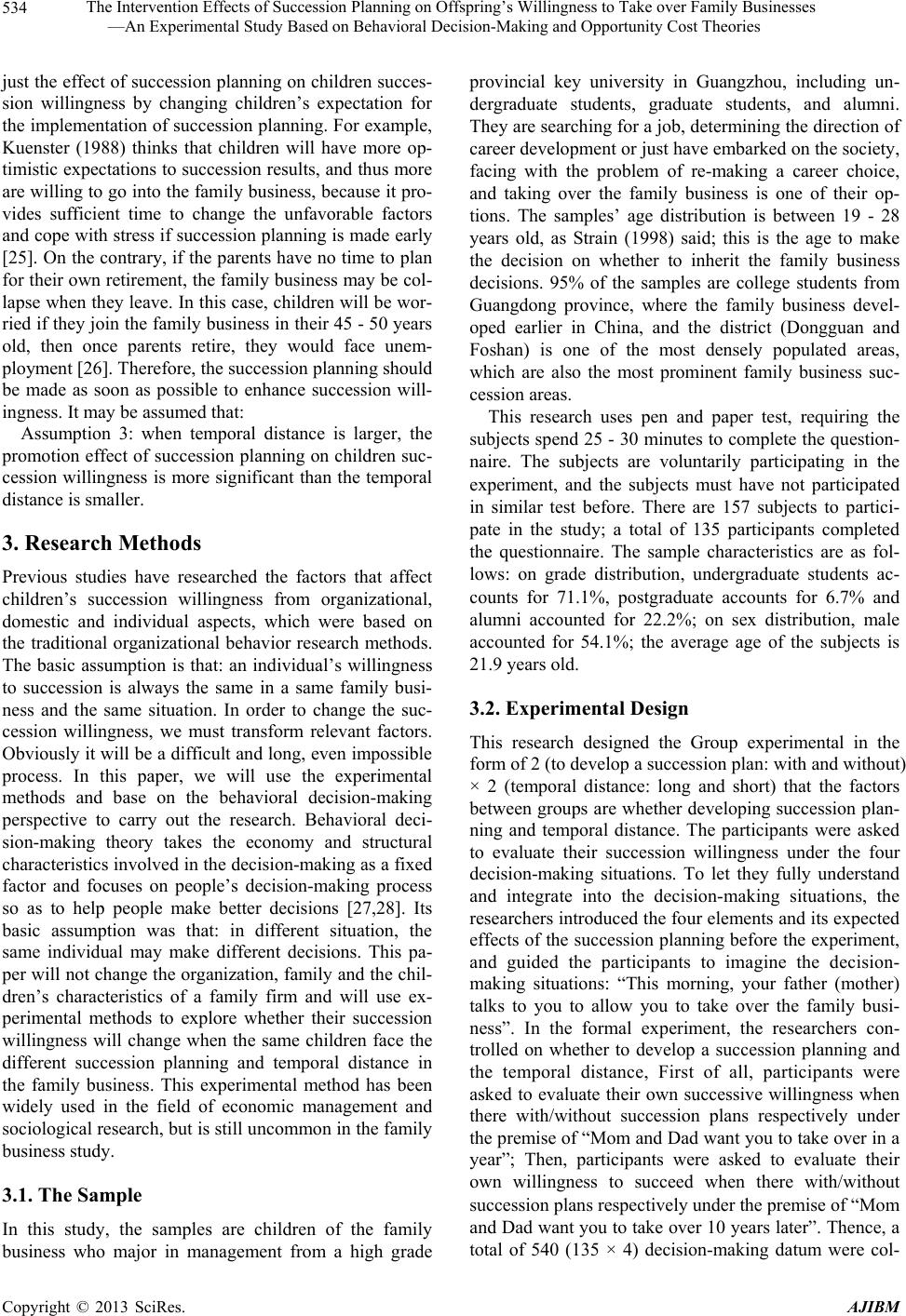 The Intervention Effects of Succession Planning on Offspring’s Willingness to Take over Family Businesses —An Experimental Study Based on Behavioral Decision-Making and Opportunity Cost Theories 534 just the effect of succession planning on children succes- sion willingness by changing children’s expectation for the implementation of succession planning. For example, Kuenster (1988) thinks that children will have more op- timistic expectation s to succession results, and thus more are willing to go into the family business, because it pro- vides sufficient time to change the unfavorable factors and cope with stress if succession planning is made early [25]. On the contrary, if the parents have no time to plan for their own retirement, the family business may be col- lapse when they leav e. In this case, children will be wor- ried if they join the family business in their 45 - 50 years old, then once parents retire, they would face unem- ployment [26]. Therefore, the succession planning should be made as soon as possible to enhance succession will- ingness. It may be assumed that: Assumption 3: when temporal distance is larger, the promotion effect of succession planning on children suc- cession willingness is more significant than the temporal distance is smaller. 3. Research Methods Previous studies have researched the factors that affect children’s succession willingness from organizational, domestic and individual aspects, which were based on the traditional organizational behavior research methods. The basic assumption is that: an individual’s willingness to succession is always the same in a same family busi- ness and the same situation. In order to change the suc- cession willingness, we must transform relevant factors. Obviously it will be a difficult and long , even impossible process. In this paper, we will use the experimental methods and base on the behavioral decision-making perspective to carry out the research. Behavioral deci- sion-making theory takes the economy and structural characteristics involved in the decision-making as a fixed factor and focuses on people’s decision-making process so as to help people make better decisions [27,28]. Its basic assumption was that: in different situation, the same individual may make different decisions. This pa- per will not change the organization , family and the chil- dren’s characteristics of a family firm and will use ex- perimental methods to explore whether their succession willingness will change when the same children face the different succession planning and temporal distance in the family business. This experimental method has been widely used in the field of economic management and sociological research, but is still uncommon in the family business study. 3.1. The Sample In this study, the samples are children of the family business who major in management from a high grade provincial key university in Guangzhou, including un- dergraduate students, graduate students, and alumni. They are searching for a job, determining the d irection of career development or just have embarked on the society, facing with the problem of re-making a career choice, and taking over the family business is one of their op- tions. The samples’ age distribution is between 19 - 28 years old, as Strain (1998) said; this is the age to make the decision on whether to inherit the family business decisions. 95% of the samples are college students from Guangdong province, where the family business devel- oped earlier in China, and the district (Dongguan and Foshan) is one of the most densely populated areas, which are also the most prominent family business suc- cession areas. This research uses pen and paper test, requiring the subjects spend 25 - 30 minutes to complete the q uestion- naire. The subjects are voluntarily participating in the experiment, and the subjects must have not participated in similar test before. There are 157 subjects to partici- pate in the study; a total of 135 participants completed the questionnaire. The sample characteristics are as fol- lows: on grade distribution, undergraduate students ac- counts for 71.1%, postgraduate accounts for 6.7% and alumni accounted for 22.2%; on sex distribution, male accounted for 54.1%; the average age of the subjects is 21.9 years old. 3.2. Experimental Design This research designed the Group experimental in the form of 2 (to develop a succession plan: with and without) × 2 (temporal distance: long and short) that the factors between groups are whether developing succession plan- ning and temporal distance. The participants were asked to evaluate their succession willingness under the four decision-making situations. To let they fully understand and integrate into the decision-making situations, the researchers introduced the four elements and its expected effects of the succession planning before the experiment, and guided the participants to imagine the decision- making situations: “This morning, your father (mother) talks to you to allow you to take over the family busi- ness”. In the formal experiment, the researchers con- trolled on whether to develop a succession planning and the temporal distance, First of all, participants were asked to evaluate their own successive willingness when there with/without succession plans respectively under the premise of “Mom and Dad want you to take over in a year”; Then, participants were asked to evaluate their own willingness to succeed when there with/without succession plans respectively under the premise of “Mom and Dad want you to take over 10 years later”. Thence, a total of 540 (135 × 4) decision-making datum were col- Copyright © 2013 SciRes. AJIBM 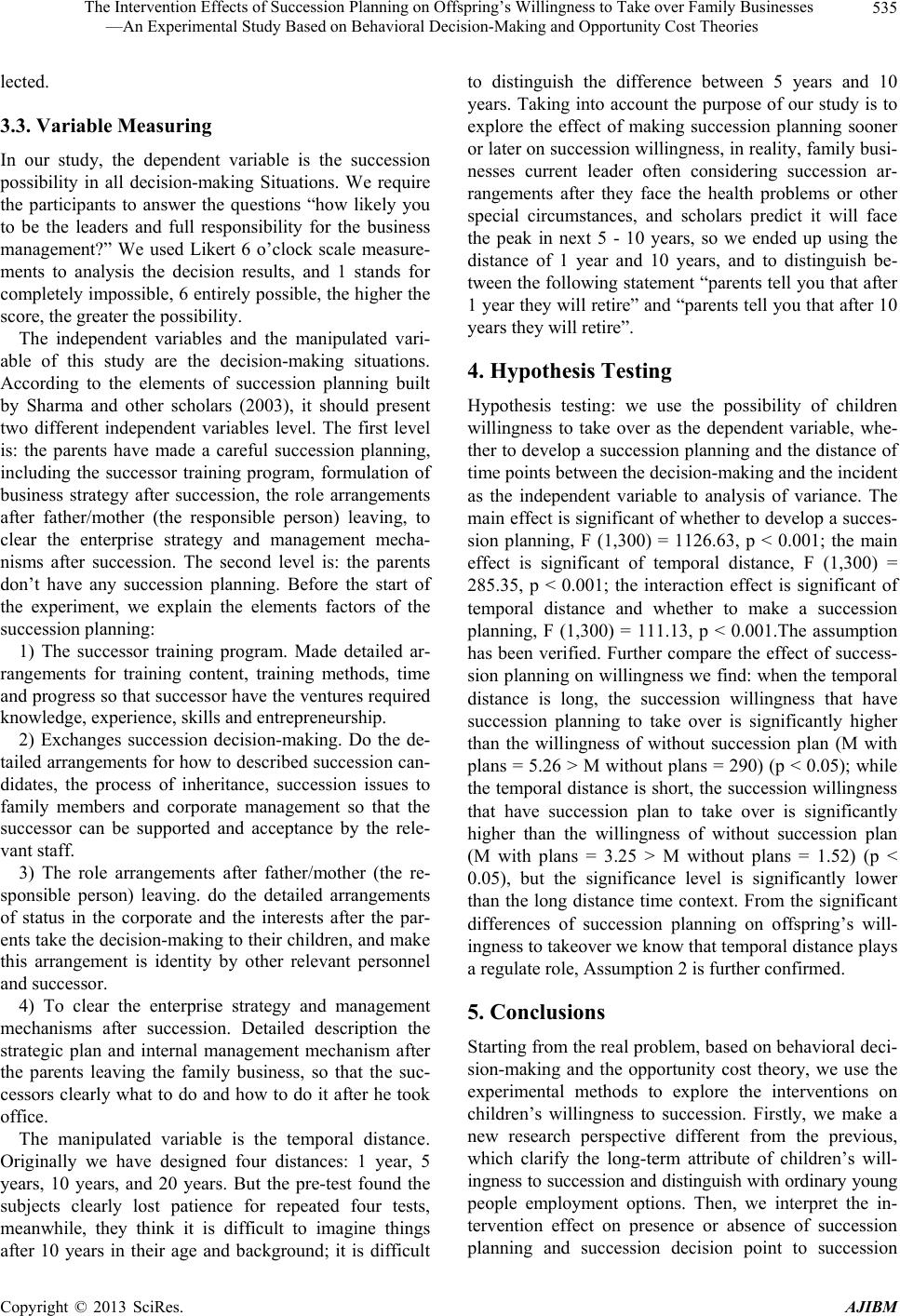 The Intervention Effects of Succession Planning on Offspring’s Willingness to Take over Family Businesses —An Experimental Study Based on Behavioral Decision-Making and Opportunity Cost Theories 535 lected. 3.3. Variable Measuring In our study, the dependent variable is the succession possibility in all decision-making Situations. We require the participants to answer the questions “how likely you to be the leaders and full responsibility for the business management?” We used Likert 6 o’clock scale measure- ments to analysis the decision results, and 1 stands for completely impossible, 6 entirely possible, the higher the score, the greater the possibility. The independent variables and the manipulated vari- able of this study are the decision-making situations. According to the elements of succession planning built by Sharma and other scholars (2003), it should present two different independent variables level. The first level is: the parents have made a careful succession planning, including the successor training program, formulation of business strategy after succession, the role arrangements after father/mother (the responsible person) leaving, to clear the enterprise strategy and management mecha- nisms after succession. The second level is: the parents don’t have any succession planning. Before the start of the experiment, we explain the elements factors of the succession planning: 1) The successor training program. Made detailed ar- rangements for training content, training methods, time and progress so that successor have the ventures required knowledge, experience, skills and entrepreneurship. 2) Exchanges succession decision-making. Do the de- tailed arrangements for how to described succession can- didates, the process of inheritance, succession issues to family members and corporate management so that the successor can be supported and acceptance by the rele- vant staff. 3) The role arrangements after father/mother (the re- sponsible person) leaving. do the detailed arrangements of status in the corporate and the interests after the par- ents take the decision-making to their children, and make this arrangement is identity by other relevant personnel and successor. 4) To clear the enterprise strategy and management mechanisms after succession. Detailed description the strategic plan and internal management mechanism after the parents leaving the family business, so that the suc- cessors clearly what to do and how to do it after he took office. The manipulated variable is the temporal distance. Originally we have designed four distances: 1 year, 5 years, 10 years, and 20 years. But the pre-test found the subjects clearly lost patience for repeated four tests, meanwhile, they think it is difficult to imagine things after 10 years in their age and background; it is difficult to distinguish the difference between 5 years and 10 years. Taking into account the purpose of our study is to explore the effect of making succession planning sooner or later on succession willingness, in reality, family bus i- nesses current leader often considering succession ar- rangements after they face the health problems or other special circumstances, and scholars predict it will face the peak in next 5 - 10 years, so we ended up using the distance of 1 year and 10 years, and to distinguish be- tween the following statement “parents tell yo u that after 1 year they will retire” and “parents tell you that after 10 years they will retire”. 4. Hypothesis Testing Hypothesis testing: we use the possibility of children willingness to take over as the dependent variable, whe- ther to develop a succession planning an d the distance of time points between the decision-making and the incident as the independent variable to analysis of variance. The main effect is significant of whether to develop a succes- sion planning, F (1,300) = 1126.63, p < 0.001; the main effect is significant of temporal distance, F (1,300) = 285.35, p < 0.001; the interaction effect is significant of temporal distance and whether to make a succession planning, F (1,300) = 111.13, p < 0.001.The assumption has been verified. Further compare the effect of success- sion planning on willingn ess we find: when the temporal distance is long, the succession willingness that have succession planning to take over is significantly higher than the willingness of without succession plan (M with plans = 5.26 > M without plans = 290) (p < 0.05); while the temporal distance is short, the succession willingness that have succession plan to take over is significantly higher than the willingness of without succession plan (M with plans = 3.25 > M without plans = 1.52) (p < 0.05), but the significance level is significantly lower than the long distance time context. From the significant differences of succession planning on offspring’s will- ingness to takeover we know that temporal distance plays a regulate role, Assumption 2 is further confirmed. 5. Conclusions Starting from the real problem, based on behavioral deci- sion-making and the opportunity cost theory, we use the experimental methods to explore the interventions on children’s willingness to succession. Firstly, we make a new research perspective different from the previous, which clarify the long-term attribute of children’s will- ingness to succession and distinguish with ordinary young people employment options. Then, we interpret the in- tervention effect on presence or absence of succession planning and succession decision point to succession Copyright © 2013 SciRes. AJIBM 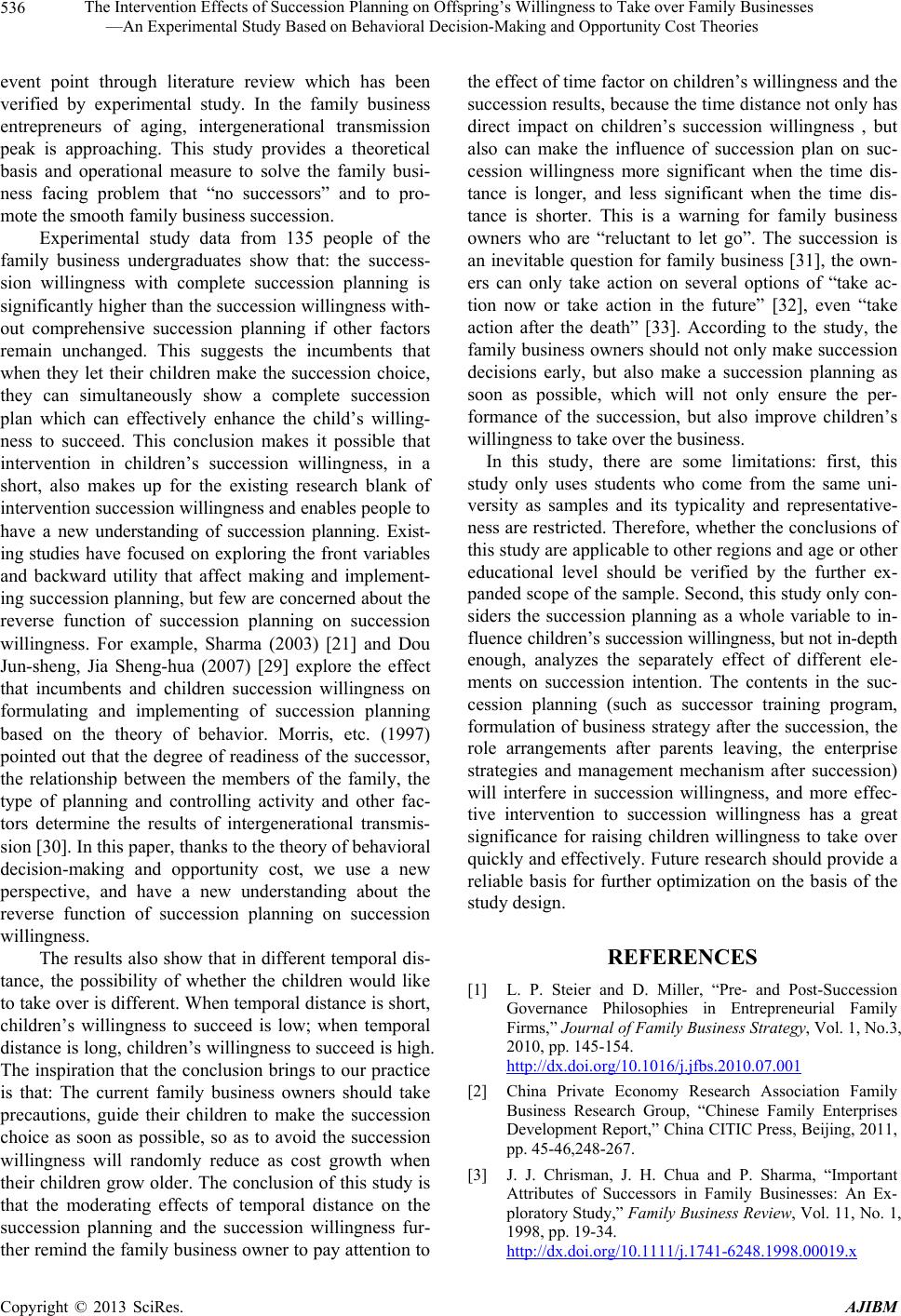 The Intervention Effects of Succession Planning on Offspring’s Willingness to Take over Family Businesses —An Experimental Study Based on Behavioral Decision-Making and Opportunity Cost Theories 536 event point through literature review which has been verified by experimental study. In the family business entrepreneurs of aging, intergenerational transmission peak is approaching. This study provides a theoretical basis and operational measure to solve the family busi- ness facing problem that “no successors” and to pro- mote the smooth family business succession. Experimental study data from 135 people of the family business undergraduates show that: the success- sion willingness with complete succession planning is significantly high er than the succession willingness with- out comprehensive succession planning if other factors remain unchanged. This suggests the incumbents that when they let their children make the succession choice, they can simultaneously show a complete succession plan which can effectively enhance the child’s willing- ness to succeed. This conclusion makes it possible that intervention in children’s succession willingness, in a short, also makes up for the existing research blank of intervention successio n willingn ess and enables p eop le to have a new understanding of succession planning. Exist- ing studies have focused on exploring the front variables and backward utility that affect making and implement- ing succession planning, but few are concerned about the reverse function of succession planning on succession willingness. For example, Sharma (2003) [21] and Dou Jun-sheng, Jia Sheng-hua (2007) [29] explore the effect that incumbents and children succession willingness on formulating and implementing of succession planning based on the theory of behavior. Morris, etc. (1997) pointed out that the degree of readiness of the successor, the relationship between the members of the family, the type of planning and controlling activity and other fac- tors determine the results of intergenerational transmis- sion [30]. In this paper, thanks to the theory of behavioral decision-making and opportunity cost, we use a new perspective, and have a new understanding about the reverse function of succession planning on succession willingness. The results also show that in different temporal dis- tance, the possibility of whether the children would like to take over is different. When temporal distance is short, children’s willingness to succeed is low; when temporal distance is long, children’s willingness to succeed is high. The inspiration that the conclusion brings to our practice is that: The current family business owners should take precautions, guide their children to make the succession choice as soon as possible, so as to avoid the succession willingness will randomly reduce as cost growth when their children grow older. The conclusion of this study is that the moderating effects of temporal distance on the succession planning and the succession willingness fur- ther remind the family business owner to pay attention to the effect of time factor on ch ildren’s willingn ess and the succession results, because the time distance not only has direct impact on children’s succession willingness , but also can make the influence of succession plan on suc- cession willingness more significant when the time dis- tance is longer, and less significant when the time dis- tance is shorter. This is a warning for family business owners who are “reluctant to let go”. The succession is an inevitable question for family business [31], the own- ers can only take action on several options of “take ac- tion now or take action in the future” [32], even “take action after the death” [33]. According to the study, the family business owners should not only make succession decisions early, but also make a succession planning as soon as possible, which will not only ensure the per- formance of the succession, but also improve children’s willingness to take over the business. In this study, there are some limitations: first, this study only uses students who come from the same uni- versity as samples and its typicality and representative- ness a re restr icted. Ther efore, whether the conclusions of this study are applicable to other regions and age or other educational level should be verified by the further ex- panded scope of the sample. Second, this study only con- siders the succession planning as a whole variable to in- flu en c e children’s succession willingness, but not in-depth enough, analyzes the separately effect of different ele- ments on succession intention. The contents in the suc- cession planning (such as successor training program, formulation of business strategy after the succession, the role arrangements after parents leaving, the enterprise strategies and management mechanism after succession) will interfere in succession willingness, and more effec- tive intervention to succession willingness has a great significance for raising children willingness to take over quickly and effectively. Future research should provide a reliable basis for further optimization on the basis of the study design. REFERENCES [1] L. P. Steier and D. Miller, “Pre- and Post-Succession Governance Philosophies in Entrepreneurial Family Firms,” Journal of Family Business Strategy, Vol. 1, No.3, 2010, pp. 145-154. http://dx.doi.org/10.1016/j.jfbs.2010.07.001 [2] China Private Economy Research Association Family Business Research Group, “Chinese Family Enterprises Development Report,” China CITIC Press, Beijing, 2011, pp. 45-46,248-267. [3] J. J. Chrisman, J. H. Chua and P. Sharma, “Important Attributes of Successors in Family Businesses: An Ex- ploratory Study,” Family Business Review, Vol. 11, No. 1, 1998, pp. 19-34. http://dx.doi.org/10.1111/j.1741-6248.1998.00019.x Copyright © 2013 SciRes. AJIBM  The Intervention Effects of Succession Planning on Offspring’s Willingness to Take over Family Businesses —An Experimental Study Based on Behavioral Decision-Making and Opportunity Cost Theories 537 [4] P. Sharma and P. G. Irving, “Four Bases of Family Busi- ness Successor Commitment: Antecedents and Conse- quences,” Entrepreneurship Theory and Practice, Vol. 29, No. 1, 2005, pp. 13-33. http://dx.doi.org/10.1111/j.1540-6520.2005.00067.x [5] A. Bjornberg and N. Nicholson, “Emotional Ownership: The Next Generation’s Relationship with the Family Firm,” Family Business Review, Vol. 25, No. 4, 2012, pp. 374-390. http://dx.doi.org/10.1177/0894486511432471 [6] Forbes Chinese net, “Forbes 2012 Chinese Family Busi- ness Survey Report,” 2012. http://www.forbeschina.com/review/201209/0019773.sht ml. [7] T. E. Stavrou and S. P. Michael, “Securing the Future of the Family Enterprise: A Model of Offspring Intentions to Join the Business,” Entrepreneurship: Theory & Practice, Vol. 23, 1998, pp. 19-39. [8] T. Zellweger, P. Sieger and F. Halter, “Should I Stay or Should I Go? Career Choice Intentions of Students with Family Business Background,” Journal of Business Ven- turing, Vol. 26, No. 5, 2011, pp. 521-536. http://dx.doi.org/10.1016/j.jbusvent.2010.04.001 [9] T. Geerts, “Willingness to Take Over the Family Busi- ness,” University of Maastricht, 2008 [10] A. L. Kristof, “Person-Organization Fit: An Integrative Review of Its Conceptualizations Measurement and Im- plications,” Personnel Psychology, Vol. 49, No. 1, 1996, pp. 1-49. http://dx.doi.org/10.1111/j.1744-6570.1996.tb01790.x [11] C. Christensen, “Management Succession in Small and Growing Enterprises,” Harvard Business School, Boston 1953. [12] T. Reuter, J. P. Ziegelmann, A. U. Wiedemann, C. Geiser, S. Lippke, B. Schuz and R. Schwarzer, “Changes in In- tentions, Planning, and Self-Efficacy Predict Changes in Behaviors: An Application of Latent True Change Mod- eling,” Journal of Health Psychology, Vol. 15, No. 6, 2010, pp. 935-947. http://dx.doi.org/10.1177/1359105309360071 [13] F. Chi, “The Exploration of Opportunity Cost Content, Expression and Use,” Journal of Changchun University of Science and Technology, Vol. 6, No. 11, 2011, pp. 27- 28,42. [14] P. Sharma, J. J. Chrisman, A. L. Pablo and J. H. Chua, “Determinants of Initial Satisfaction with the Succession Process in Family Firms: A Conceptual Model,” Entre- prenuership Theory and Practice, Vol. 25, No. 3, 2001, pp. 17-35. [15] P. Sharma, J. J. Chrisman and J. H. Chua, “Predictors of Satisfaction with the Succession Process in Family Firms,” Journal of Business Venturing, Vol. 18, No. 5, 2003, pp. 667-687. http://dx.doi.org/10.1016/S0883-9026(03)00015-6 [16] R. M. Dawes, “Behavioral Decision Making and Judg- ment,” In: T. Daniel, S. T. Fiske and G. Lindzey, Eds., The Handbook of Social Psychology, Vol. 1-2, 4th Edition, McGraw-Hill Gilbert, New York, 1998, pp. 497-548. [17] X. Wang, C.-L. Yu and C.-B. Liu, “The Association Be- tween Time Interval and Future Event Valence Mental Construal Process Perceptive,” Acta Psychologica Sinica, Vol. 6, No. 44, 2011, pp. 807-817. [18] G. T. Lumpkin and K. H. Brigham, “Long-Term Orienta- tion and Intertemporal Choice in Family Firms,” Entre- preneurship Theory and Practice, Vol. 35, No. 6, 2011, pp. 149-1169. http://dx.doi.org/10.1111/j.1540-6520.2011.00495.x [19] T. Hubler, “Ten Most Prevalent Obstacles to Family- Business Succession Planning,” Family Business Review, Vol. 12, No. 2, 1999, pp. 117-122. http://dx.doi.org/10.1111/j.1741-6248.1999.00117.x [20] I. Lansberg, “The Succession Conspiracy: Resistance to Succession Planning in First Generation Family,” Family Business Review, Vol. 1, No. 2, 1988, pp. 119-143. http://dx.doi.org/10.1111/j.1741-6248.1988.00119.x [21] P. Sharma, J. J. Chrisman and J. H. Chua, “Succession Planning as Planned Behavior: Some Empirical Results,” Family Business Review, Vol. 16, No. 1, 2003, pp. 1-15. http://dx.doi.org/10.1111/j.1741-6248.2003.00001.x [22] I. Stamm and C. Lubinski, “Crossroads of Family Busi- ness Research and Firm Demography—A Critical As- sessment of Family Business Survival Rates,” Journal of Family Business Strategy, Vol. 7, No. 2, 2011, pp. 117- 127. http://dx.doi.org/10.1016/j.jfbs.2011.07.002 [23] K. M. File and R. A. Prince, “Attribution for Family Business Failure: The Heir’s Perspective,” Family Busi- ness Review, Vol. 9, No. 2, 1996, pp. 171-184. http://dx.doi.org/10.1111/j.1741-6248.1996.00171.x [24] Y. Trope and N. Liberman, “Temporal Construal,” Psy- chological Review, Vol. 110, No. 3, 2003, p. 403. http://dx.doi.org/10.1037/0033-295X.110.3.403 [25] R. Kuenster, “Business Succession Simplified,” Best’s Review (Life/Health), Vol. 89, No. 7, 1988, pp. 63-64. [26] J. Cory, “Preparing Your Successor: Family Ownership,” Hardware Age, Vol. 227, No. 7, 1990, p. 74. [27] M. H. Bazerman, “Negotiator Judgment: A Critical Look at the Rationality Assumption,” American Behavioral Scientist, Vol. 27, No. 2, 1983, pp. 211-228. http://dx.doi.org/10.1177/000276483027002007 [28] W. O. Bearden, “A Measure of Long-Term Orientation: Development and Validation,” Journal of the Academy of Marketing Sc ience, Vol. 34, No. 3, 2006, pp. 456-467. http://dx.doi.org/10.1177/0092070306286706 [29] J.-S. Dou and S.-H. Jia, “Wishes of the Individual, the Family Commitment and Implementation of Family Busi- ness Succession Plan,” Management of Sun Yat-sen, 2007, Vol. 2, No. 4, pp. 1-18. [30] M. H. Morris, R. W. Williams and D. Nel, “Factors In- fluencing Family Business Succession,” International Journal of Entrepreneurial Behaviour & Research, 1996, Vol. 2, No. 3, pp. 68-81. http://dx.doi.org/10.1108/13552559610153261 [31] B. Dyck, et al., “Passing the Baton: The Importance of Sequence, Timing, Technique and Communication in Executive Succession,” Journal of Business Venturing, 2002, Vol. 17, pp. 143-162. Copyright © 2013 SciRes. AJIBM  The Intervention Effects of Succession Planning on Offspring’s Willingness to Take over Family Businesses —An Experimental Study Based on Behavioral Decision-Making and Opportunity Cost Theories Copyright © 2013 SciRes. AJIBM 538 http://dx.doi.org/10.1016/S0883-9026(00)00056-2 [32] T. O’Donoghue and M. Rabin, “Take Action Now or Take Action in the Future?” In: C. F. Kai Mole, G. Lowenstein and M. Rabin, Ed., Behavioral Economics Progress, Renmin University Press, Beijing, 2010, pp. 261-293. [33] J. P. Marshall, R. L. Sorenson, K. H. Brigham, E. Wieling, A. Reifman and R. Wampler, “The Paradox for the Fam- ily Firm CEO: Owner Age Relationship to Succession- Related Processes and Plans,” Journal of Business Ven- turing, Vol. 21, No. 3, 2006, pp. 348-368. http://dx.doi.org/10.1016/j.jbusvent.2005.06.004
|